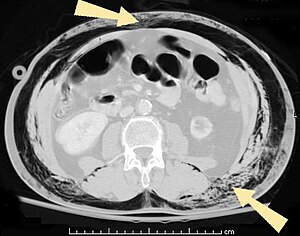Subcutaneous emphysema
| Subcutaneous emphysema | |
|---|---|
 |
|
| An abdominal CT scan of a patient with subcutaneous emphysema (arrows) | |
| Classification and external resources | |
| Specialty | emergency medicine |
| ICD-10 | T79.7, T81.8 |
| ICD-9-CM | 958.7, 998.81 |
| DiseasesDB | 29756 |
| MedlinePlus | 003286 |
| MeSH | D013352 |
Subcutaneous emphysema is when gas or air is in the layer under the skin. Subcutaneous refers to the tissue beneath the skin, and emphysema refers to trapped air. It is sometimes abbreviated SCE or SE and also called tissue emphysema, or Sub Q air. Since the air generally comes from the chest cavity, subcutaneous emphysema usually occurs on the chest, neck and face, where it is able to travel from the chest cavity along the fascia. Subcutaneous emphysema has a characteristic crackling feel to the touch, a sensation that has been described as similar to touching Rice Krispies; this sensation of air under the skin is known as subcutaneous crepitation.
Numerous etiologies of subcutaneous emphysema have been described. Pneumomediastinum was first recognized as a medical entity by Laennec, who reported it as a consequence of trauma in 1819. Later, in 1939, at The Johns Hopkins Hospital, Dr. Louis Hamman described it in postpartum woman; indeed, subcutaneous emphysema is sometimes known as Hamman's syndrome. However, in some medical circles, it can instead be more commonly known as Macklin's Syndrome after L. Macklin, in 1939, and M.T. and C.C. Macklin, in 1944, who cumulatively went on to describe the pathophysiology in more detail.
Subcutaneous emphysema can result from puncture of parts of the respiratory or gastrointestinal systems. Particularly in the chest and neck, air may become trapped as a result of penetrating trauma (e.g., gunshot wounds or stab wounds) or blunt trauma. Infection (e.g., gas gangrene) can cause gas to be trapped in the subcutaneous tissues. Subcutaneous emphysema can be caused by medical procedures and medical conditions that cause the pressure in the alveoli of the lung to be higher than that in the tissues outside of them. Its most common causes are pneumothorax and a chest tube that has become occluded by a blood clot or fibrinous material. It can also occur spontaneously due to rupture of the alveoli with dramatic presentation. When the condition is caused by surgery it is called surgical emphysema. The term spontaneous subcutaneous emphysema is used when the cause is not clear. Subcutaneous emphysema is not typically dangerous in and of itself, however it can be a symptom of very dangerous underlying conditions, such as pneumothorax. Although the underlying conditions require treatment, subcutaneous emphysema usually does not; small amounts of air are reabsorbed by the body. However, subcutaneous emphysema can be uncomfortable and may interfere with breathing, and is often treated by removing air from the tissues, for example by using large bore needles, skin incisions or subcutaneous catheterization.
...
Wikipedia
